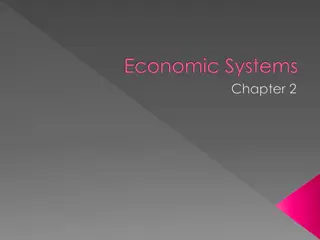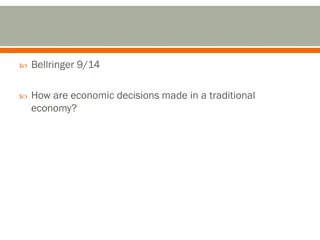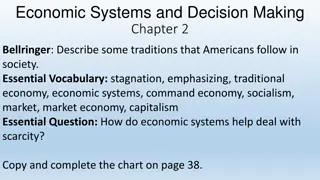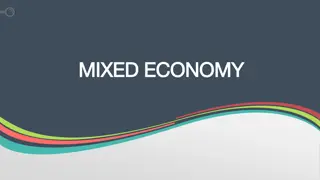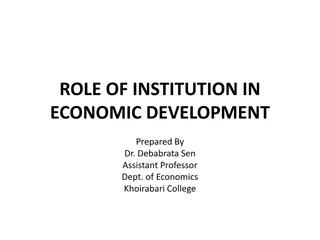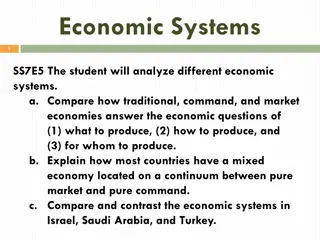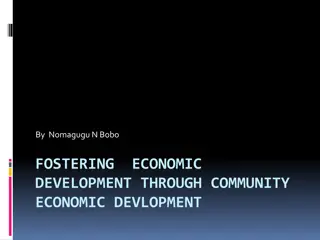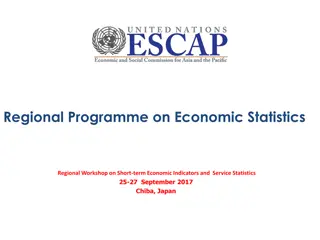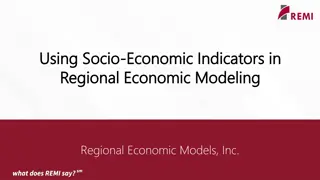Understanding Economic Systems and Questions
Explore the concepts of traditional, command, and market economies, and how they answer key economic questions. Learn about economic systems in Canada, Cuba, and Brazil, and grasp the fundamental economic questions of what to produce, how to produce, and for whom to produce. Understand the basics of supply and demand, scarcity, and different economic systems in a concise manner.
Download Presentation

Please find below an Image/Link to download the presentation.
The content on the website is provided AS IS for your information and personal use only. It may not be sold, licensed, or shared on other websites without obtaining consent from the author. Download presentation by click this link. If you encounter any issues during the download, it is possible that the publisher has removed the file from their server.
E N D
Presentation Transcript
ECONOMICS WHAT IS IT?
SS6E1 SS6E1 The student will analyze different economic systems. a. Compare how traditional, command, and market, economies answer the economic questions of 1-what to produce, 2-how to produce, and 3-for whom to produce. b. Explain how most countries have a mixed economy located on a continuum between pure market and pure command. c. Compare and contrast the basic types of economic systems found in Canada, Cuba, and Brazil.
SS6E1A-ECONOMIC QUESTIONS Economics=making decisions about distributing limited resources to get the unlimited number of things we want & need
SS6E1A-ECONOMIC QUESTIONS 3 BASIC QUESTIONS WHAT to produce? HOW to produce? FOR WHOM to produce? BASICALLY WHAT are we going to make? HOW are we going to make it? WHO are we going to make it for/sell it to?
SS6E1A-ECONOMIC QUESTIONS Supply=amount of goods available Demand=how many consumers want the goods Law of Supply & Demand= determines price of goods/services based on supply & demand Scarcity=limited supply of something
SS6E1A-ECONOMIC QUESTIONS Economic Systems Traditional Command Market Mixed 1. 2. 3. 4.
SS6E1A 1. TRADITIONAL Exchange of goods or services based on customs or traditions Jobs are usually passed down from generation to generation (farming, hunting & gathering, cattle herding) Ex. Yanomamo Indians in Brazil & Venezuela
SS6E1A 2. COMMAND Economy in which the government owns most industries and makes most economic decisions Quota=how much to produce in a given time Government assigns quota to each worker so that everyone will have what they need when they need it Prices & wages are set by government Ex. Cuba
SS6E1A 3. MARKET Economy where consumers help determine what is to be produced by buying or not buying certain goods or services AKA free enterprise, capitalism, and laissez-faire Ex. US, Mexico, Brazil
SS6E1B 4. MIXED ECONOMY There are NO pure command or market economies All economies have characteristics of both, but favor one more than other
SS6E1C-COMPARING ECONOMIC SYSTEMS Cuba Command Economy government controls nearly all businesses but some farmers are allowed to sell extra goods after meeting their quotas Brazil Market Economy government has rules to govern business & it owns some industries such as steel production Economic System?? Mexico: Market Economy although the government owns & operates the energy companies US: Market Economy government makes rules to govern business but government does not own businesses and does not control production or prices
SS6E1C-COMPARING ECONOMIC SYSTEMS Cuba Government planners Brazil Mostly private citizens and corporations; government controls larger industries such as steel What to produce? (who decides?) How to produce? (who decides) For Whom to produce? (who decides?)
SS6E1C-COMPARING ECONOMIC SYSTEMS Cuba Government planners Brazil Mostly private citizens and corporations ; government controls larger industries such as steel Mostly private citizens and corporations ; government controls larger industries such as steel Who decides distribution methods for goods and services? Who owns businesses and farms? Mostly owned by government; some private ownership of small farms or businesses
SS6E1C-COMPARING ECONOMIC SYSTEMS Cuba Government planners Brazil Buyers and sellers based on supply and demand Could take several months (somewhat time consuming) Who decides prices for goods and services? How difficult is it to start your own business? Very little private business is allowed
SS6E2 SS6E2 The student will give examples of how voluntary trade benefits buyers and sellers in Latin America and the Caribbean and Canada. a. Explain how specialization encourages trade between countries. b. Compare and contrast different types of trade barriers, such as tariffs, quotas, and embargos. c. Explain the functions of the North American Free Trade Agreement (NAFTA). d. Explain why international trade requires a system for exchanging currencies between nations.
SS6E2A- SPECIALIZATION Division of Labor= when work is divided into different parts and each worker is allowed to become an expert in his/her part of the work (specialization) Countries may specialize in producing certain goods that they can trade for goods they need from other countries
SS6E2B- TRADE BARRIERS Trade=voluntary exchange of goods and services among people and countries Both parties benefit when trade is voluntary & non-fraudulent
SS6E2B- TRADE BARRIERS Some countries limit trade by creating trade barriers. They believe trade barriers will help the workers in their own country. Tariffs=tax on imports Quotas=specific limit placed on the number of imports that may enter a country Embargo=government order stopping trade with another country (US has embargo against Cuba)
SS6E2C- NAFTA North American Free Trade Agreement= (1994) US, Mexico, & Canada signed agreement to remove all tariffs on goods traded among these 3 countries Created world s largest free trade zone Feared factories would move to Mexico where labor costs less thus increasing air pollution in Mexico & W. US
SS6E2D- CURRENCIES Currency= money people use to make trade easier Exchange rate= price of one nation s currency in terms of another nation s currency determined by supply & demand
SS6E3 SS6E3 The student will describe factors that influence economic growth and examine their presence or absence in Latin America. a. Explain the relationship between investment in human capital (education and training) and gross domestic product (GDP). b. Explain the relationship between investment in capital (factories, machinery, and technology) and gross domestic product (GDP). c. Describe the role of natural resources in a country s economy. d. Describe the role of entrepreneurship.
SS6E3A-HUMAN CAPITAL & GDP Gross Domestic Product: Gross = total of all goods and services Domestic = produced within the borders of a country Product = final goods and services produced within one year
SS6E3- GDP STATISTICS The EU collectively is #1 at $15.7 trillion United States is #2 at $15.6 trillion China is #3 at $12.4 trillion India is #4 at $4.7 trillion Brazil is #8 at $2.3 trillion Mexico is #12 at $1.7 trillion Venezuela is #34 at $402.1 billion Cuba is #68 at $114.1 billion CIA World Fact Book
SS6E3A-HUMAN CAPITAL & GDP SS6E3B- PHYSICAL CAPITAL & GDP The higher the GDP, the higher the standard of living Must invest in human capital & physical capital to increase GDP Human = education, training, healthcare Physical = factories, machinery, technology, buildings, etc.
SS6E3C- NATURAL RESOURCES Natural Resources = gifts of nature such as forests, water, and fertile soil A country with lots of natural resources can trade them to other countries to get things they need A country with few natural resources must import the things they need, adding to the cost of goods & services The more natural resources = the higher the standard of living
SS6E3D- ENTREPRENEURSHIP Entrepreneur = person who starts his own business usually with his own money Entrepreneurs hire workers, pay taxes, and encourage trade within the country & with other countries (creating more jobs!) Nearly impossible to be an entrepreneur in Cuba Cuba has low GDP Chile allows entrepreneurs and has laws to protect their businesses Chile has high GDP




